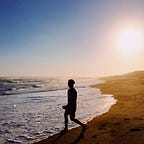#30DayMapChallenge 2021 Recap — Part 1
The Holy Month for Mapmakers
Last year, unfortunately, I just found out about this challenge so I was unable to complete it. This year I was more ‘well prepared’ and finally able to finish it 30/30.
The challenge is initiated by Topi Tjukanov in 2019, the idea is to create and publish maps based on specific themes each day (listed below) using the hashtag #30DayMapChallenge on social media.
Personally, participating in challenges like this is more like encouraging myself to be a highly productive person and think creatively every day. It’s hard, I admit it 😅 but the rest is so much fun. For sure, the maps I found out there during the challenges days made me realize that I’m (still) not good enough. Anyway, I will divide the recap into 3 parts, with 10 maps or days in each part. So, here it is…
Day 1 — Points
Geographically, Indonesia is located between 3 tectonic plates (Australia, Eurasia, and the Pacific). Therefore, both volcanic and tectonic earthquakes often happen in Indonesia.
As we can see on the map, most of the earthquake points are close to active faults and fault zones. No wonder if the Indonesian government plans to build (or maybe relocate?) a new capital city in East Kalimantan on the island of Borneo.
Source :
Day 2 — Lines
Banjarmasin is the capital of South Kalimantan (Borneo) Province, this city is called “City of a Thousand Rivers” and brings the famous floating market as one of its river cultures. But, does Banjarmasin literally has 1000 rivers?
Source :
- OpenStreetMap
Day 3 — Polygons
I think this map can be a reflection that Indonesia as a developing country still has a lot of work to do to achieve equitable development, especially in the eastern part of Indonesia. However, I’m pretty sure when the country turns 100 years old in 2045, we can reach the Indonesia Golden Generation Project and become one of the world’s economic giants.
P.S.
Believe me, the data was vector polygons, not raster pixels 😅
Source :
Day 4 — Hexagons
The need for land settlements became higher since the population gradually increased. But the availability of land for urban areas is getting narrower over time. It sometimes makes people choose a vulnerable location. I made a hexagon map to find the relationship between land slope and people density in Malang, East Java. How’s the result? check it out.
Sources :
Day 6 — Red
In the last two decades, Indonesia has lost 27.7 million hectares (Mha) of tree cover, equivalent to 17% total of tree cover in this country. Riau Province had the most tree cover loss at 3.90Mha compared to an average of 840kha. But, there is good news that deforestation in Indonesia hits a record low in 2020 fell by 75% to its lowest level since 1990.
Sources :
Day 7 — Green
Lombok is somehow similar in size, density and shares some cultural heritage with the neighboring island of Bali to the west. That’s why (IMHO) Lombok is an alternative tourist destination besides Bali. The area with the highest percentage of tree covers in Lombok is mostly in the central part which is Rinjani National Park.
Sources :
Day 8 — Blue
Natural solutions for climate change potentially provide a substantial amount of climate change mitigation benefit. One of the ecosystems that can store carbon is marine and coastal ecosystems, therefore it can be called Blue Carbon and mangrove carbon stocks are the strengths on the coast, also need more attention.
Sources :
Day 9 — Monochrome
Light pollution is a side effect of industrial civilization. Its sources include building exterior and interior lighting, advertising, commercial properties, offices, factories, streetlights, and illuminated sporting venues.
Sources :
Day 10 — Raster
Kelud is an active volcano located in East Java, Indonesia. Its massive eruption in 2014 left precious memories for me who live only about 1.5 hours drive from its peak.
This map shows the comparison of Kelud right after the eruption in 2014 with current conditions via Landsat 8 in Google Earth Engine. The growth of vegetation indicates that the condition of Kelud is now fully recovered.
Link to Interactive Map
I also added personal documentation when I went to Kelud in 2016, at that time the tunnel for access to the crater was still under (re)construction.
FYI the function of this tunnel is to maintain the crater lake’s volume and thus reduce the hot mudflow hazard if the eruption occurs.
Actually, I have some documentation in 2013 when it still has a lava dome, unfortunately the file is corrupted with my memory card and I have no idea how to restore it until today.
Nowadays visitors can go closer to the crater to enjoy the beauty of Kelud.
